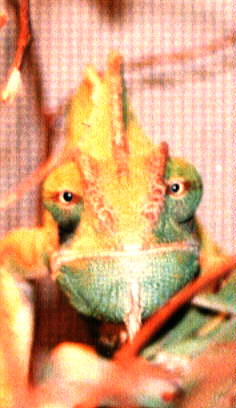|
Breeding the Veiled Chameleon by Petra Spiess 
Veiled chameleons are a hardy and prolific species that is relatively easy
to breed. Captive bred veiled chameleon babies can be seen everywhere on the reptile
market today, even in pet shops, and wholesale for anywhere from $25-50 depending on the
age of the animal. The first step in breeding veiled chameleons is to make sure you have a
male and a female. Fortunately, veiled chameleons can be reliably sexed at birth.
Most female veileds advertise their sexual maturity by displaying robins-egg blue colors on their sides and casque. Not all females will display this however. The best method to judge a female's receptiveness to breeding is to but the female with a male. How she reacts is the best indication. If the female turns black, gapes widely, hisses, and rocks back and forth, upon seeing a male, she is not ready for mating. If the female displays this behavior, remove her from the enclosure immediately return her to her own cage. If she is receptive, she will retain her passive coloration, and slowly walk away from the male. After some running around, copulation will generally take place. When the female has been inseminated, she will conveniently let the keeper know by altering her coloration dramatically. Inseminated females turn black with yellow and green spots. When this coloration is observed, remove the female. After a successful copulation, oviposition will occur between 30-40 days, however, it is advisable to put an egg laying chamber in the cage on day 20 just in case. The egglaying chamber is easily constructed by filling a 5 gallon bucket 6-12 inches full of moist sand or sand/peat moss mixture. What is wanted is a substrate that will facilitate tunneling. When the female is close to oviposition, she will often appear "restless" and wander around the cage looking for her preferred nesting spot. The female almost always choose the provided egg laying chamber, but occasionally, if a large plant is included, she will dig a nest below the root ball of a large potted plant. When she is serious about laying, she will begin to dig a tunnel, when the tunnel is sufficient for her needs (this usually take several hours) she will turn around and lay her eggs. After oviposition, the female will bury the eggs completely. Take care when digging up the eggs, as the females tend to lay them somewhere at the bottom of the container, and in a very tightly packed ball. Also, when looking for eggs, do not become disenheartened when you cannot find them right away, it often takes some serious, and delicate prospecting to find the egg mass (especially if the egg laying container is large!). Veiled chameleon clutches vary considerably, from 12 to as many as 80 eggs. In the wild, veileds lay moderate clutches of 12-20 eggs. Females that lay huge clutches generally do not live past a few clutches, the production of this many eggs is extremely taxing and it seems it directly contributes to their early demise. At this point, the eggs should be dug up and artificially incubated. The female will be exhausted (wouldn't you?), so she should be put in a quiet place with proper conditions and offered a little water and food. Veiled females can become receptive to breeding again several weeks after oviposition. Even without a second breeding, many females will go on to lay a second clutch from retained sperm 80-100 days after the first breeding. Eggs can be incubated in slightly moist vermiculite at 75-80 degrees. Fertile eggs are bright white, and when illuminated from behind in a dark room, are suffused with blood vessels. Infertile eggs are usually yellow and do not have blood vessels. During incubation, the eggs must be spaced a least one inch apart (to prevent premature hatching) and should be kept in the dark. After 150-200 days, the eggs should hatch. Right before hatching, the eggs will "sweat"-form little beads of water on their surface, and will begin to cave in. A day or so after this, the eggs should hatch. Hatchling veiled chameleons are relatively hardy and can be housed in 10 gallon vivaria with a screen top, or (even better) and all screen enclosure. The temperature on the warm end should be 88-95 degrees and 75-80 on the cool end. Small live plants, such as pothos, are good to include in the enclosure. The babies will eat them and they will provide some hiding spots. As hatchlings, 6-7 babies can be kept in one enclosure, as long as food is liberally provided. Baby veileds should be fed pinhead crickets supplemented with calcium powder every day. They should be sprayed to provide drinking water and to raise the relative humidity every other day. Once the babies are two months old, the sexes should be separated both physically and visually. At this time, most babies are well established and ready to go to new homes.
|
Recent Chameleon Classifieds: |